Pedro Nolasco Cruz Vergara
Pedro Nolasco Cruz Vergara, Molina (Chile), April 18, 1857 – Santiago de Chile, November 11, 1939 was a literary critic, novelist, writer, and political chileno.[1]
Pedro Nolasco Cruz Vergara | |
|---|---|
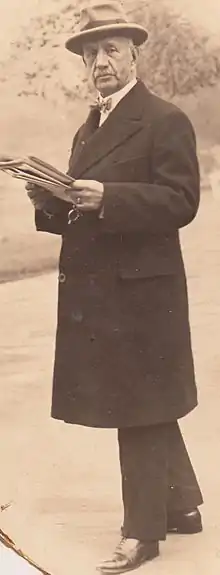 | |
| Born | Pedro Nolasco Cruz Vergara April 18, 1857 Molina, Chile |
| Died | November 11, 1939 Santiago, Chile |
| Nationality | Chilean |
| Genre | Literary critic and writer |
| Literary movement | Literary critic and novelist |
Biography
Family
He was son of Nicholas de la Cruz Donoso (1827–1860) and Elisa Martinez de Vergara and Loys, she was daughter Pedro Nolasco Vergara Albano and Mercedes Vergara-Loys. He had one sister, Elisa Cruz Vergara, whom he married in 1885 with Francisco Javier Sanchez Fresno. He was great-grandson of Vicente de la Cruz y Bahamonde nephew and grandson of Nicolas de la Cruz y Bahamonde and Anselmo de La Cruz y Bahamonde.[2]
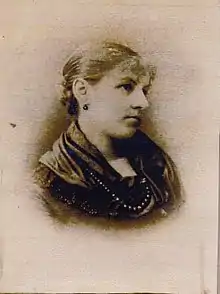
He married his first cousin, Susana Correa Vergara (January 10, 1862 – January 31, 1953), she was a daughter of Vicente Correa Albano and Agustina Martínez de Vergara and Loys, who had 9 children. They were Fabio, Nicolas, Pedro Nolasco, Susana, Elisa, Mercedes, Julia, Eduardo and Manuel.
Well-known grandchildren
Pedro Nolasco Cruz Vergara had the following well-known grandchildren:
- Alberto Cruz Covarrubias (1917–2013), architect and Chilean Premio Nacional de Artes Plásticas in 1975.
- Eugenio Cruz Vargas (1923–2014), painter and poet.
- Fabio Cruz Prieto (1927–2007), architect.
Studies
He did his primary education at the College of Parent Escolapios Santiago de Chile. His secondary studies conducted in the College of the Sacred Hearts of Santiago or College of the French Parents. Later, he was graduated as a lawyer in the Universidad de Chile on October 27, 1877.[3]
Literary critic and writer
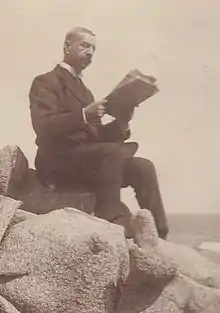
He was a literary critic and writer, ascribing in the field of analysis, within the so-called cultural nationalism. He was the author of the novels "Fantasias Humoriscicas' '(1881), Estaban (1883), The passage of Venus (1884) and Flor de Campo" (1886). Despite the success I obtained these works among his contemporaries, he is mainly remembered for his essays on Chilean literature. Within this work of analysis and literary criticism, highlighted by the publication of some literary works such as Platicas Literarias (1889), Critical studies to don José Victorino Lastarrias (1917), Studies on Chilean literature (1926–1940, 3 vols.),[4] "Desolation" by Gabriela Mistral and "Al vivir" by Francisco Concha and Castillo (1929), Biography Carlos Walker Martínez (1904), Tales (1930) and the posthumous book entitled Bilbao and Lastarrias (1944).[5][6]
Professor and literary chronicler
He was critic literary of newspaper El Independiente, La Union and El Diario Ilustrado until his death. In addition, he taught literature at the Universidad de Chile and College French brothers
Public and private life
.jpg.webp)
On the other hand, was secretary of war and navy in the period 1903–1913, Notary public of finance of Santiago between 1913 and 1939, and secretary general of the Conservative Party from 1901 to 1928.
He was owner of the ranch the Molino (1877–1939) and the Viña Antivero (1897–1939), in the commune of Rome, in the department of San Fernando.
Some editions
 Manual de Literatura Preceptiva, 1900.
Manual de Literatura Preceptiva, 1900.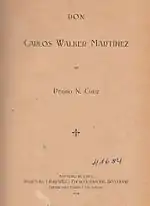 Don Carlos Walker Martínez, Biografía, 1904.
Don Carlos Walker Martínez, Biografía, 1904.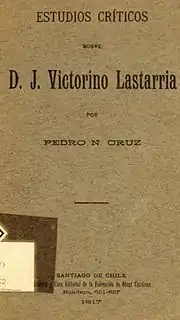 Estudios Críticos sobre José Victorino Lastarria, 1917.
Estudios Críticos sobre José Victorino Lastarria, 1917. Estudios sobre la Literatura Chilena, 1926.
Estudios sobre la Literatura Chilena, 1926. Estudios sobre la Literatura Chilena, 1940.
Estudios sobre la Literatura Chilena, 1940.
References
- [Study on Chilean literature, 1940, foreword Pastene written by M. Correa, October 1940]
- Biography of Pedro Nolasco Cruz Vergara
- Anales de la Universidad de Chile
- Literary criticism about Marta Brunet (1940)
- Biblioteca del Congreso Nacional
- History of Literature Illustrated Francisco A. Encina, written by Leopoldo Castedo, vol. 11, pp. 144–152
External links
| Wikimedia Commons has media related to Pedro Nolasco Cruz Vergara. |

- Anales de la Universidad de Chile, Número 44. Imprenta del Siglo, 1873, página 9
- Google about Pedro Nolasco Cruz Vergara